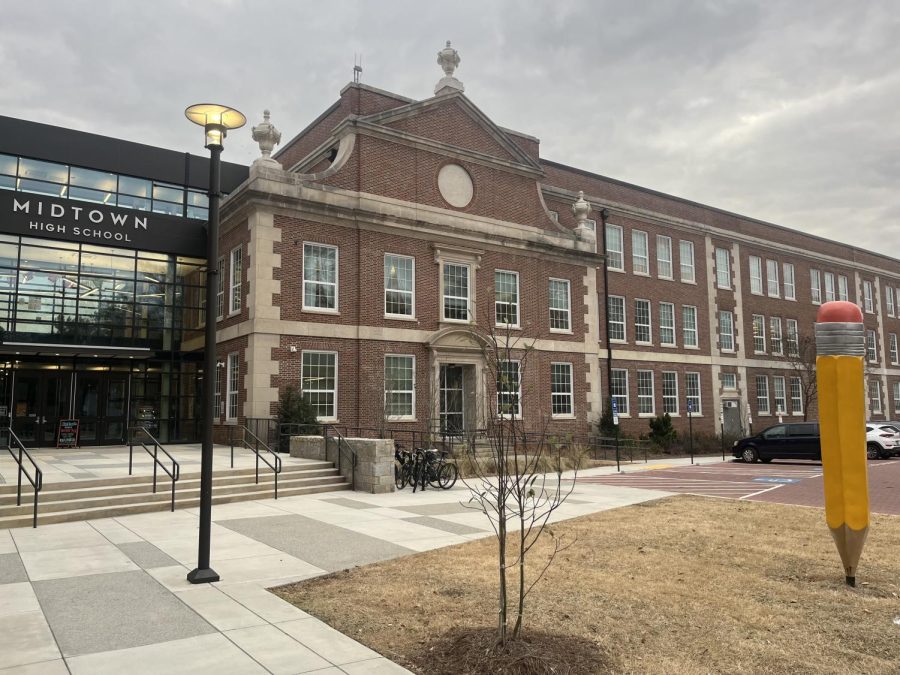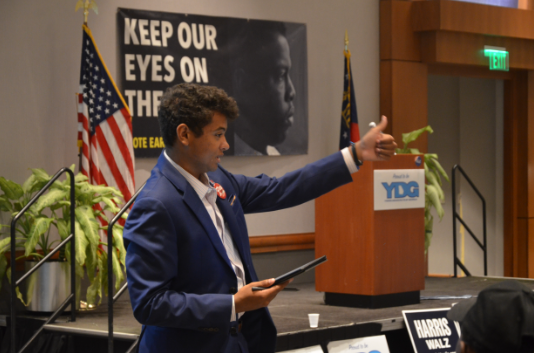Plans addressing high school overcapacity take shape
Midtown is one of Atlanta Public Schools’ focuses when tackling overcapacity within the district. Maynard Jackson and Douglass High School are also overcrowded.
March 24, 2023
Atlanta Public Schools has proposed two scenarios to resolve overcrowding at Midtown and is encouraging community input ahead of a formal recommendation in April.
Midtown is one of three APS high schools under review due to overcrowding. With a calculated capacity cap at 1,600 students, Midtown is projected to have an enrollment of 1,711 students in the 24-25 school year.
“Addressing capacity at Midtown is necessary because the school is overcrowded right now, and based on our best estimates from our experts using all the information we have, that overcrowding is going to get worse instead of better,” board member Cynthia Briscoe Brown said. “Students have a better educational experience and teachers and other staff have a better working experience when they’re not dealing with significant overcrowding.”
Scenario 1 calls for what APS describes as additional enhancements and innovations at Midtown without rezoning, and Scenario 2 involves redistricting the Centennial Academy zone from Midtown to Washington High School. Any redistricting would go into effect in the fall of 2024.
Under the first scenario, APS said it would work with Midtown to review innovations that would relieve the effects of overcrowding, consider next steps if capacity increases, conduct a residency review, and assess available resources to address overcapacity. There currently isn’t a public timeline or many details laying out how Scenario 1 would proceed.
“No rezoning would put pressure on Midtown to try to figure out how to reutilize its space and consider what it needed,” school board member Michelle Olympiadis said. “It would mean that [Principal] Dr. Bockman and her staff would have to sit down and figure out how they’re going to reutilize the high school space to make it more feasible for the kids that are coming in.”
Under the second scenario, Midtown’s boundaries would be redrawn, rezoning 219 students from Midtown to Washington, reducing Midtown to 90% capacity and raising Washington to 67% enrollment of its capacity. Washington’s current enrollment is 831 with a capacity of 1,625 students.
One of the many concerns when it comes to redistricting is racial equity. Around 90% of Centennial students are African-American. Removing Centennial from the Midtown Cluster would reduce the number of Black students at Midtown by 6.6%, according to APS.
“I do believe that it’s very important to have as diverse a student body as we possibly can at every school: whether that’s racial, or ethnic, or income or gender identity – every one of the intersectionalities that makes for an exciting community,” Briscoe Brown said. “But we also have to look at geography, and as a practical matter, Centennial is at one end of the Midtown High School attendance zone.”
Centennial parent Janet Kinard would like Centennial to remain in the Midtown Cluster.
“The overall feeling is that [Centennial] is really aligned with the other schools in the Midtown Cluster as far as preparation for Midtown,” Kinard said. “So, things like accelerated science, accelerated math, preparing students for rigorous AP classes, and what that means – there’s a pretty close alignment there.”
Kinard said she is most concerned with gaps in opportunities that come with redrawing attendance boundaries, and that it doesn’t look as though the same resources are available districtwide.
“There’s just so much disparity between the schools, and I don’t mean from an achievement standpoint – like from the numbers on tests,” Kinard said. “One of the biggest concerns for me is, if you’re redistricted from one school to another, are the same level classes available? Is your child going to have the same opportunities and access, depending on what school they go to?”
Centennial Family Liaison Toshia Meadows has two daughters who attended Centennial for seven years. She thinks many parents might not be fully aware of the resources available at Washington.
“Last year, we had the principal from Washington come and give us a presentation on some of the things that they are doing at Washington High School, and I think we were all kind of blown away about the amazing things that they were doing that a lot of other schools are not,” Meadows said.
However, while Meadows recognizes the need for overcrowding to be addressed, she also wants APS to create more scenarios than those put forth in early March because she thinks the two options at hand automatically push Centennial out of the Midtown Cluster.
Olympiadis sympathizes with those who are upset about potential redistricting, acknowledging many choose to live in certain neighborhoods with the expectation they will attend specific schools.
“I really wish, and I have been pushing this for a long time, that we had a better plan in place for redistricting because what’s happening right now is very disruptive for the communities that are being impacted,” she said.
Briscoe Brown said, though in different ways, both overcrowded and under capacity schools limit students’ educational opportunities.
“It’s important to me that we not limit any student in the kinds of courses they can take, or the opportunities they have to interact with their teachers or the extracurriculars that they want to participate in,” Briscoe Brown said. “We have to find ways to make sure that all students have everything they need. That’s how I view this, and whatever option or options get us to that point are the options that I favor.”
APS expects to endorse one of the two scenarios under consideration sometime in early April. The district has been gathering community input and encouraging stakeholders to weigh in via Let’s Talk, a service for community members to communicate with the district.
“We will work together with you to formulate solutions and incorporate your advice and recommendations into the decisions to the maximum extent possible,” APS said in the Midtown Cluster Options for addressing capacity slide deck.
Olympiadis also said community members should check Infinite Campus for news messages and Facebook for live streams and meeting recordings.
Midtown Cluster parent Brittany Schwartzwald lives in the Mary Lin Elementary zone and is critical of the way the process has been conducted so far, saying it has lacked clarity and fidelity.
At the beginning of the year, Schwartzwald said APS asked stakeholders to contribute potential solutions to overcrowding, but they weren’t informed of capacity and enrollment numbers. She said APS isn’t truly listening to the community or engaging them authentically or meaningfully; so, community engagement feels like a waste of time.
“I think the problem with discussing the scenarios is the lack of transparency in the process of getting to these scenarios,” Schwartzwald said. “In the meantime, they were coming up with capacity and enrollment numbers, which we never discussed, and then they just presented those a couple of weeks ago, and now they presented us plans. There’s been no community engagement in this at all; it’s been completely performative.”
Schwartzwald said neither scenario under consideration is ideal.
“I think everyone’s concerned with equity, and I don’t have an answer,” she said. “There is no easy solution to the overcrowding at Midtown.”
Schwartzwald is also critical of Superintendent Dr. Lisa Herring, saying she should be more visible throughout the process.
“I hope I can see the school board hold Superintendent Herring accountable,” Schwartzwald said. “…I think I could feel differently about the two scenarios if I felt like we had a leader who was really invested, engaged and committed.”
APS did not respond for comment.
Some stakeholders believe other potential solutions were dismissed prematurely and think that, instead of turning the Inman building into Virginia-Highland Elementary, grade levels could have been configured differently in cluster schools. Schwartzwald suggested, for example, making Midtown Cluster elementary schools K-4 institutions, with Howard holding grades 5 through 7, the Inman building housing grades 8 and 9 and Midtown housing grades 10 through 12.
“Another elementary school wasn’t what the cluster needed,” Schwartzwald said.
On March 9, APS asked stakeholders to fill out a Mentimeter survey asking which of the two scenarios they preferred. The ratio was close to 50/50, with approximately 140 responses. Briscoe Brown said, no matter what happens, about half of the community will be pleased with the plan while the other half will not be.
“I hope that in either case, the half of the community that doesn’t feel like they’re getting their preferred choice will tuck in and work together and really join hands and link arms with everybody else to make whatever the outcome is the best it can possibly be,” she said.








Ruth Alexander • Mar 25, 2023 at 10:24 am
Thanks for the information. So much more informative than the AJC.